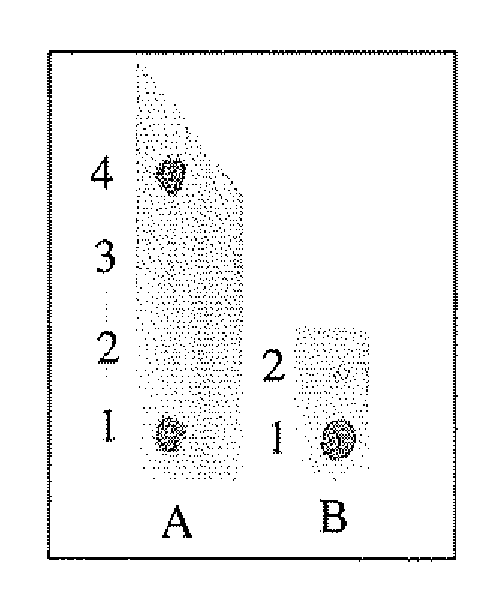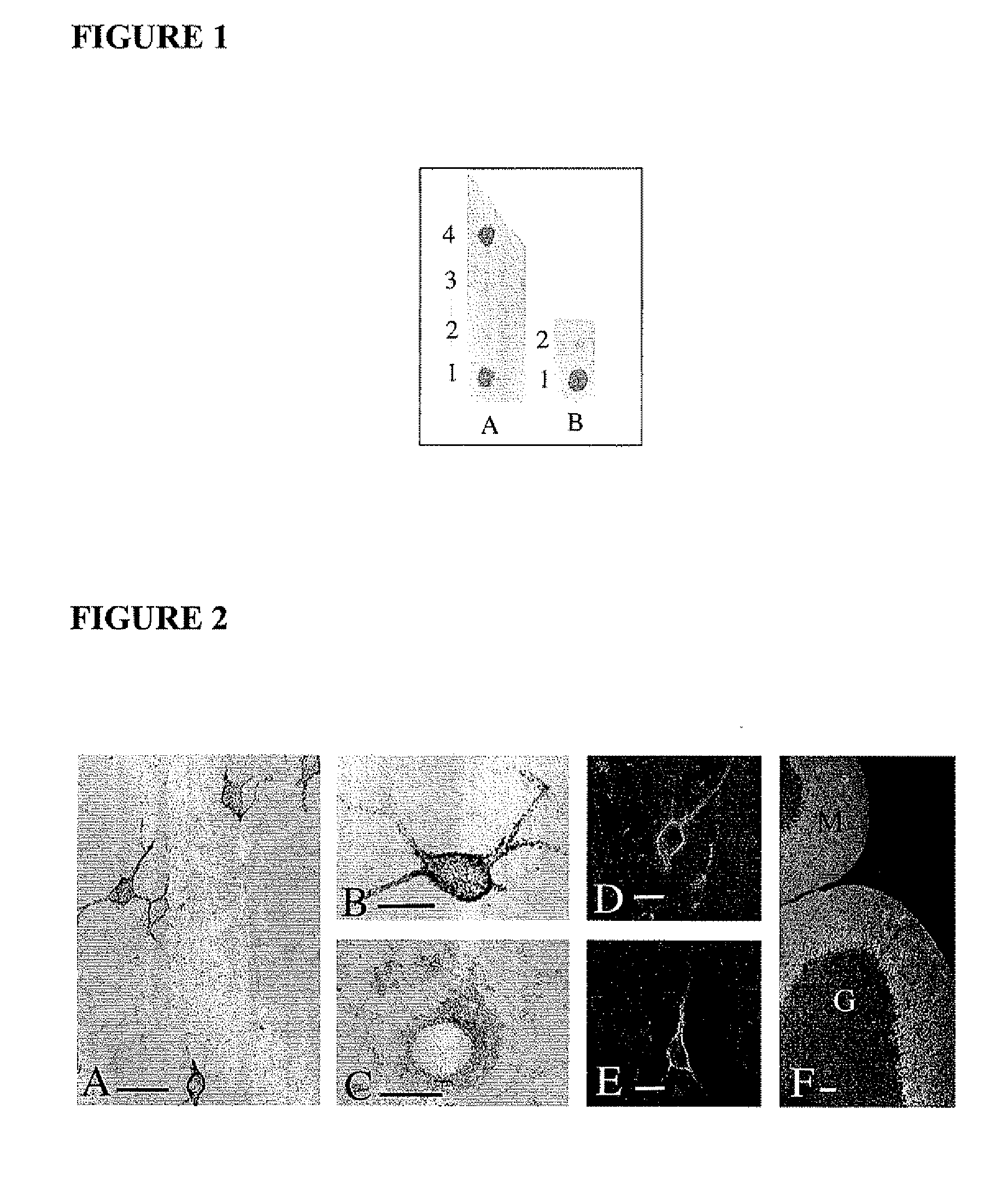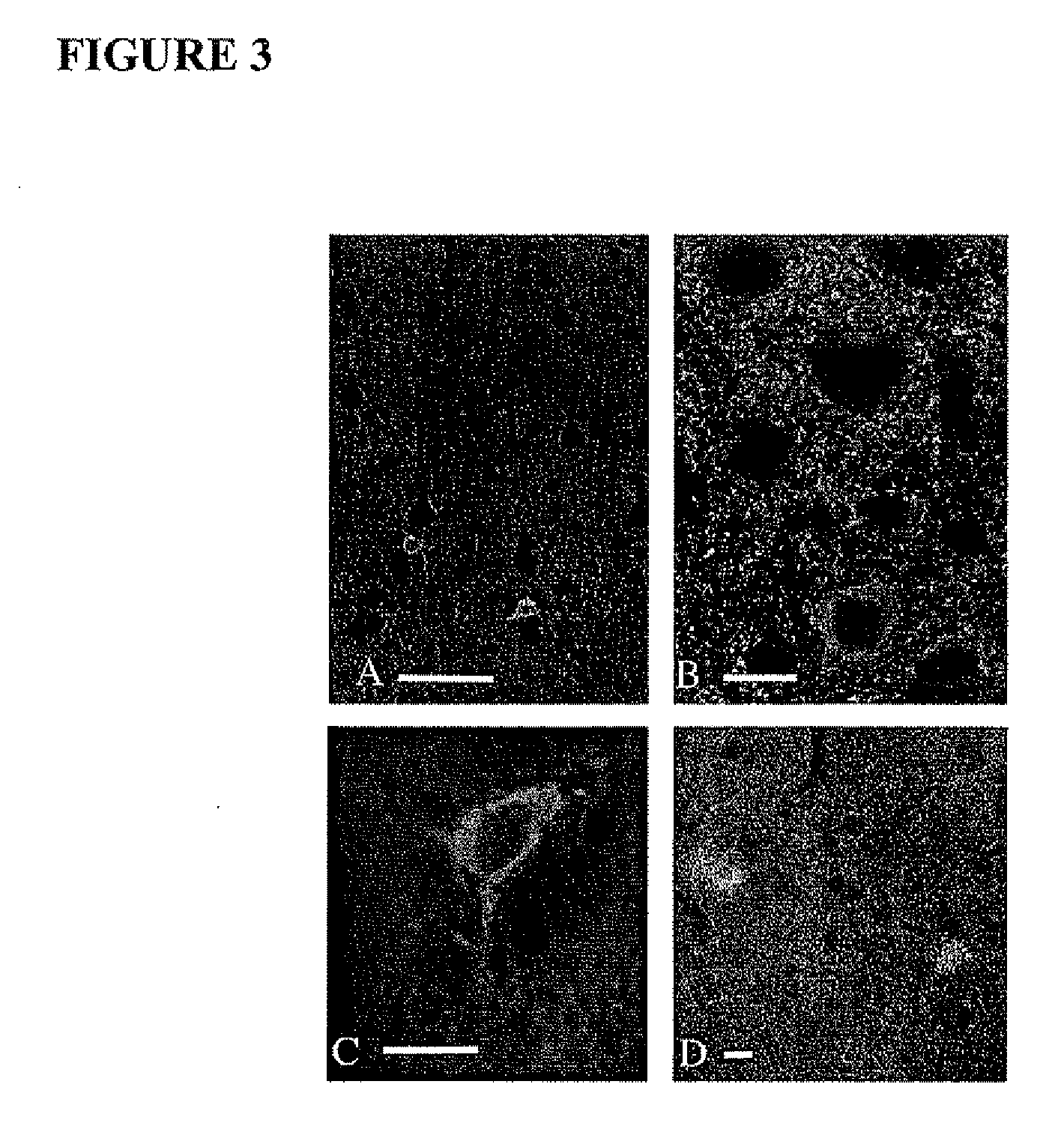Detection of a biomarker of aberrant cells of neuroectodermal origin in a body fluid
a biomarker and aberrant cell technology, applied in the field of detection of aberrant cells of neuroectodermal origin in body fluids, can solve the problems of not being able to quantify unable to meet the needs of scavengers, so as to facilitate the making of decisions, reduce the risk of further damage, and reduce the risk of infection.
- Summary
- Abstract
- Description
- Claims
- Application Information
AI Technical Summary
Benefits of technology
Problems solved by technology
Method used
Image
Examples
example 1
Detection of GLAST1b in Tissue
[0068]Antibodies were raised against a unique amino acid synthetic peptide corresponding to the amino acids encoded by the splice site between exons 8 and 10 of GLAST to enable selective detection of GLAST1b (the antibodies are available from Prof. David Pow, The University of Newcastle, Newcastle, NSW, Australia). The aim of the present study was to determine if GLAST1b was present in the CNS and if so, its cellular compartmentalization.
1. Methods
[0069]Animal experiments complied with the guidelines of the National Health and Medical Research Council (NHMRC, Australia). Antisera were generated in rabbit [14], using the unique 11 amino acid peptide H2N-QIITIRDRLRT (SEQ ID No. 1) of GLAST1b (referred to hereafter as peptide 1), which spans the splice region between exons 8 and 10, (see Macnab L T and Pow D V, (2007) [24], the contents of which is incorporated herein in its entirety by cross-reference). The peptide was coupled to porcine thyroglobulin, (S...
example 2
Expression of GLAST1b in Pig Brain
[0084]The distribution of GLAST1b in the hypoxic neonatal pig brain was examined. In this model, the damage is variable between animals as assessed by independent blind scoring conducted by histological analysis on cresyl violet stained sections. Some animals typically experience only damage to white matter whilst others experience damage to either restricted regions of grey matter or in the most severe cases, to large areas of grey and white matter.
2.1 Methods
[0085]Animal experiments complied with the guidelines of the National Health & Medical Research Council (NHMRC) (Australia).
2.1.1 Animal Preparation
[0086]One day old pigs were anaesthetised using propofol (10 mg / kg / h) and alfentanil (50 μg / kg / h) iv. The pigs were intubated and ventilated using a neonatal ventilator, with oxygen and air to maintain arterial CO2 at 35-45 mmHg and oxygen saturation 92-96%. A radiant warmer was used to maintain rectal temperature at 39.0±0.5° C. Following stabilis...
example 3
D-glutamate is Accumulated by GLAST1b
[0112]A study was undertaken to evaluate accumulation of D-glutamate by GLAST1b. Briefly, hypercanic hypoxia was induced in one day old pigs essentially as described in Example 2.1.1. Control pigs were subjected to anaesthesia but no hypoxia and also allowed to recover for 72 hours as described above. The pigs were euthanased by an overdose of sodium pentobarbital, and the brains rapidly removed and placed into ice cold oxygenated artificial cerebrospinal fluid (CSF) (Ames media). 250 μm-thick slices were to room temperature before warming to 36° C., for the performance of transport studies. The temperatures used were slightly higher that those typically used for electrophysiology, and thus closer to physiological normality as transporter activity is greatly reduced if the temperature is significantly lowered. The neuroprotective effects of hypothermia that are evident at lower temperatures are also avoided since they are contraindicated in these...
PUM
 Login to View More
Login to View More Abstract
Description
Claims
Application Information
 Login to View More
Login to View More - R&D
- Intellectual Property
- Life Sciences
- Materials
- Tech Scout
- Unparalleled Data Quality
- Higher Quality Content
- 60% Fewer Hallucinations
Browse by: Latest US Patents, China's latest patents, Technical Efficacy Thesaurus, Application Domain, Technology Topic, Popular Technical Reports.
© 2025 PatSnap. All rights reserved.Legal|Privacy policy|Modern Slavery Act Transparency Statement|Sitemap|About US| Contact US: help@patsnap.com



